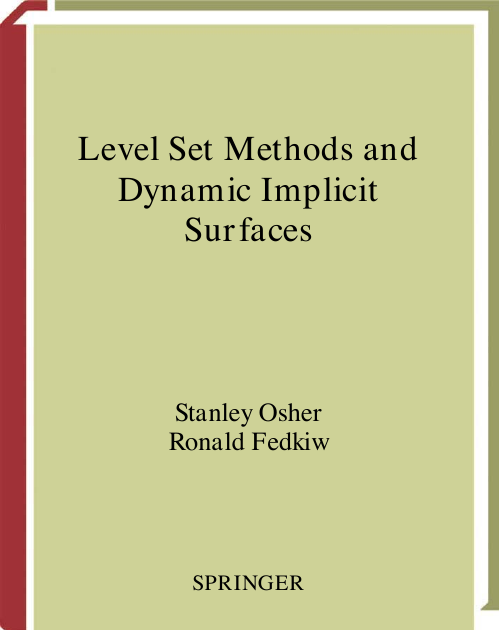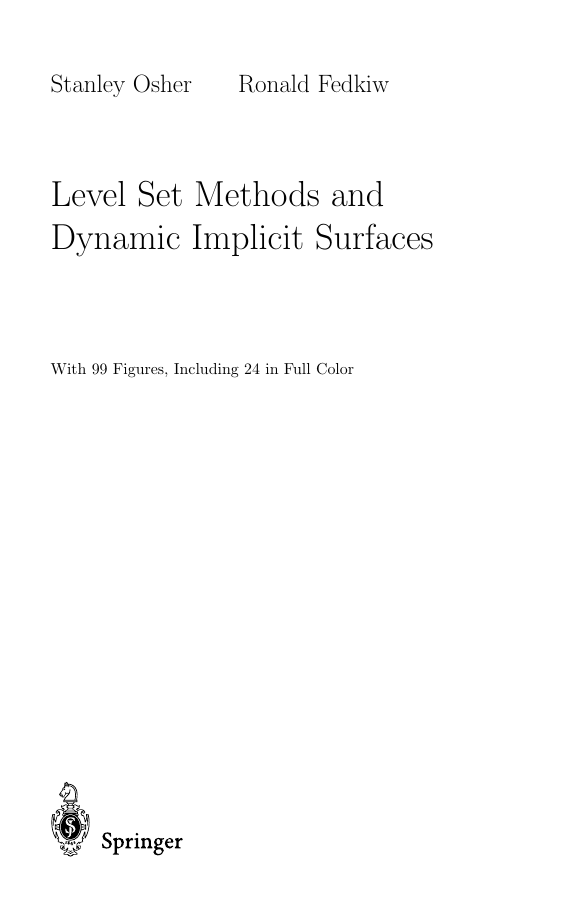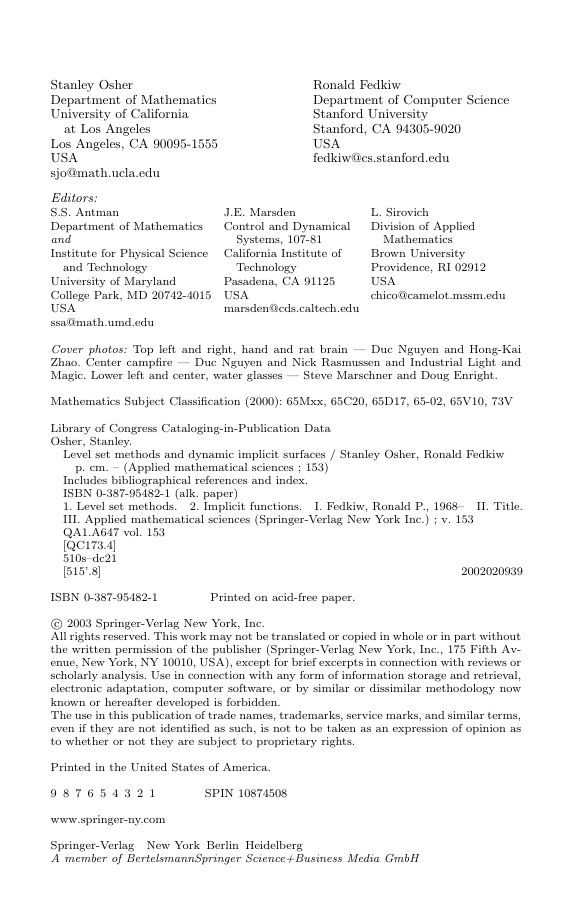Level Set Methods and
Dynamic Implicit
Surfaces
Stanley Osher
Ronald Fedkiw
SPRINGER
�
Applied Mathematical Sciences
Volume 153
Editors
S.S. Antman
J.E. Marsden
L. Sirovich
Advisors
J.K. Hale
J. Keller
C.S. Peskin
P. Holmes
B.J. Matkowksy
J. Keener
A. Mielke
K.R. Sreenivasan
Springer
New York
Berlin
Heidelberg
Hong Kong
London
Milan
Paris
Tokyo
�
This page intentionally left blank
�
Stanley Osher
Ronald Fedkiw
Level Set Methods and
Dynamic Implicit Surfaces
With 99 Figures, Including 24 in Full Color
�
Stanley Osher
Department of Mathematics
University of California
at Los Angeles
Los Angeles, CA 90095-1555
USA
sjo@math.ucla.edu
Ronald Fedkiw
Department of Computer Science
Stanford University
Stanford, CA 94305-9020
USA
fedkiw@cs.stanford.edu
Editors:
S.S. Antman
Department of Mathematics
and
Institute for Physical Science California Institute of
J.E. Marsden
Control and Dynamical
Systems, 107-81
and Technology
Technology
University of Maryland
College Park, MD 20742-4015 USA
USA
ssa@math.umd.edu
Pasadena, CA 91125
marsden@cds.caltech.edu
L. Sirovich
Division of Applied
Mathematics
Brown University
Providence, RI 02912
USA
chico@camelot.mssm.edu
Cover photos: Top left and right, hand and rat brain — Duc Nguyen and Hong-Kai
Zhao. Center campfire — Duc Nguyen and Nick Rasmussen and Industrial Light and
Magic. Lower left and center, water glasses — Steve Marschner and Doug Enright.
Mathematics Subject Classification (2000): 65Mxx, 65C20, 65D17, 65-02, 65V10, 73V
Library of Congress Cataloging-in-Publication Data
Osher, Stanley.
Level set methods and dynamic implicit surfaces / Stanley Osher, Ronald Fedkiw
p. cm. – (Applied mathematical sciences ; 153)
Includes bibliographical references and index.
ISBN 0-387-95482-1 (alk. paper)
1. Level set methods.
III. Applied mathematical sciences (Springer-Verlag New York Inc.) ; v. 153
QA1.A647 vol. 153
[QC173.4]
510s–dc21
[515’.8]
I. Fedkiw, Ronald P., 1968–
2. Implicit functions.
II. Title.
2002020939
Printed on acid-free paper.
ISBN 0-387-95482-1
c 2003 Springer-Verlag New York, Inc.
All rights reserved. This work may not be translated or copied in whole or in part without
the written permission of the publisher (Springer-Verlag New York, Inc., 175 Fifth Av-
enue, New York, NY 10010, USA), except for brief excerpts in connection with reviews or
scholarly analysis. Use in connection with any form of information storage and retrieval,
electronic adaptation, computer software, or by similar or dissimilar methodology now
known or hereafter developed is forbidden.
The use in this publication of trade names, trademarks, service marks, and similar terms,
even if they are not identified as such, is not to be taken as an expression of opinion as
to whether or not they are subject to proprietary rights.
Printed in the United States of America.
9 8 7 6 5 4 3 2 1
SPIN 10874508
www.springer-ny.com
Springer-Verlag New York Berlin Heidelberg
A member of BertelsmannSpringer Science+Business Media GmbH
�
Dedicated with love to Katy, Brittany, and Bobbie
�
This page intentionally left blank
�
Preface
Scope, Aims, and Audiences
This book, Level Set Methods and Dynamic Implicit Surfaces is designed
to serve two purposes:
Parts I and II introduce the reader to implicit surfaces and level set
methods. We have used these chapters to teach introductory courses on the
material to students with little more than a fundamental math background.
No prior knowledge of partial differential equations or numerical analysis
is required. These first eight chapters include enough detailed information
to allow students to create working level set codes from scratch.
Parts III and IV of this book are based on a series of papers published
by us and our colleagues. For the sake of brevity, a few details have been
occasionally omitted. These chapters do include thorough explanations and
enough of the significant details along with the appropriate references to
allow the reader to get a firm grasp on the material.
This book is an introduction to the subject. We have given examples of
the utility of the method to a diverse (but by no means complete) collection
of application areas. We have also tried to give complete numerical recipes
and a self-contained course in the appropriate numerical analysis. We be-
lieve that this book will enable users to apply the techniques presented here
to real problems.
The level set method has been used in a rapidly growing number of areas,
far too many to be represented here. These include epitaxial growth, opti-
mal design, CAD, MEMS, optimal control, and others where the simulation
�
















 2023年江西萍乡中考道德与法治真题及答案.doc
2023年江西萍乡中考道德与法治真题及答案.doc 2012年重庆南川中考生物真题及答案.doc
2012年重庆南川中考生物真题及答案.doc 2013年江西师范大学地理学综合及文艺理论基础考研真题.doc
2013年江西师范大学地理学综合及文艺理论基础考研真题.doc 2020年四川甘孜小升初语文真题及答案I卷.doc
2020年四川甘孜小升初语文真题及答案I卷.doc 2020年注册岩土工程师专业基础考试真题及答案.doc
2020年注册岩土工程师专业基础考试真题及答案.doc 2023-2024学年福建省厦门市九年级上学期数学月考试题及答案.doc
2023-2024学年福建省厦门市九年级上学期数学月考试题及答案.doc 2021-2022学年辽宁省沈阳市大东区九年级上学期语文期末试题及答案.doc
2021-2022学年辽宁省沈阳市大东区九年级上学期语文期末试题及答案.doc 2022-2023学年北京东城区初三第一学期物理期末试卷及答案.doc
2022-2023学年北京东城区初三第一学期物理期末试卷及答案.doc 2018上半年江西教师资格初中地理学科知识与教学能力真题及答案.doc
2018上半年江西教师资格初中地理学科知识与教学能力真题及答案.doc 2012年河北国家公务员申论考试真题及答案-省级.doc
2012年河北国家公务员申论考试真题及答案-省级.doc 2020-2021学年江苏省扬州市江都区邵樊片九年级上学期数学第一次质量检测试题及答案.doc
2020-2021学年江苏省扬州市江都区邵樊片九年级上学期数学第一次质量检测试题及答案.doc 2022下半年黑龙江教师资格证中学综合素质真题及答案.doc
2022下半年黑龙江教师资格证中学综合素质真题及答案.doc